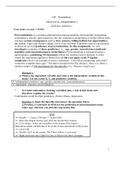Presentation
2.2P - Practical Assignment 5 - Solutions - Manana Mañana
- Course
- Institution
2.2P - Practical Assignment 5 - Solutions - Manana Mañana. Answers to the 5th practical assignment for Bachelor 2 Statistics. The presentation is due coming Friday Oct 28. Syntax used is .
[Show more]



